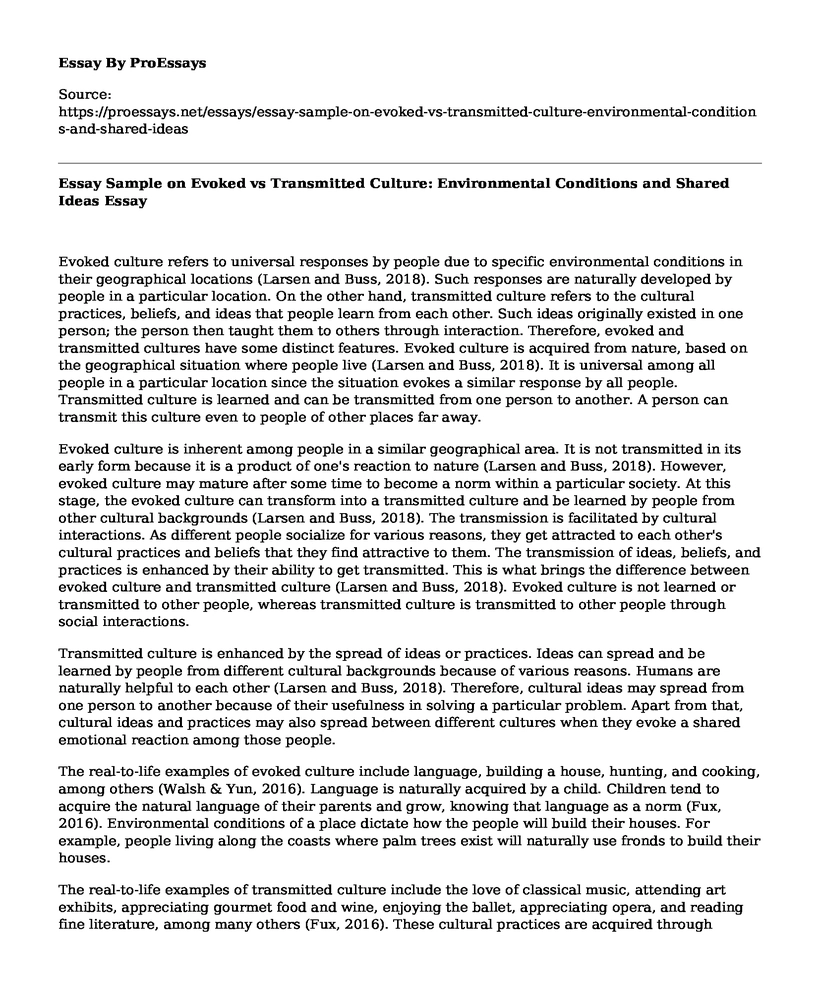Evoked culture refers to universal responses by people due to specific environmental conditions in their geographical locations (Larsen and Buss, 2018). Such responses are naturally developed by people in a particular location. On the other hand, transmitted culture refers to the cultural practices, beliefs, and ideas that people learn from each other. Such ideas originally existed in one person; the person then taught them to others through interaction. Therefore, evoked and transmitted cultures have some distinct features. Evoked culture is acquired from nature, based on the geographical situation where people live (Larsen and Buss, 2018). It is universal among all people in a particular location since the situation evokes a similar response by all people. Transmitted culture is learned and can be transmitted from one person to another. A person can transmit this culture even to people of other places far away.
Evoked culture is inherent among people in a similar geographical area. It is not transmitted in its early form because it is a product of one's reaction to nature (Larsen and Buss, 2018). However, evoked culture may mature after some time to become a norm within a particular society. At this stage, the evoked culture can transform into a transmitted culture and be learned by people from other cultural backgrounds (Larsen and Buss, 2018). The transmission is facilitated by cultural interactions. As different people socialize for various reasons, they get attracted to each other's cultural practices and beliefs that they find attractive to them. The transmission of ideas, beliefs, and practices is enhanced by their ability to get transmitted. This is what brings the difference between evoked culture and transmitted culture (Larsen and Buss, 2018). Evoked culture is not learned or transmitted to other people, whereas transmitted culture is transmitted to other people through social interactions.
Transmitted culture is enhanced by the spread of ideas or practices. Ideas can spread and be learned by people from different cultural backgrounds because of various reasons. Humans are naturally helpful to each other (Larsen and Buss, 2018). Therefore, cultural ideas may spread from one person to another because of their usefulness in solving a particular problem. Apart from that, cultural ideas and practices may also spread between different cultures when they evoke a shared emotional reaction among those people.
The real-to-life examples of evoked culture include language, building a house, hunting, and cooking, among others (Walsh & Yun, 2016). Language is naturally acquired by a child. Children tend to acquire the natural language of their parents and grow, knowing that language as a norm (Fux, 2016). Environmental conditions of a place dictate how the people will build their houses. For example, people living along the coasts where palm trees exist will naturally use fronds to build their houses.
The real-to-life examples of transmitted culture include the love of classical music, attending art exhibits, appreciating gourmet food and wine, enjoying the ballet, appreciating opera, and reading fine literature, among many others (Fux, 2016). These cultural practices are acquired through learning due to social interactions with people from different cultural backgrounds where such practices are appreciated (Walsh & Yun, 2016). Not all people may naturally like football. However, interactions between people who like football and those who do not like football can trigger an interest in football. As a result, those who never liked football would end up liking it because they learned it from interacting with football fans. The learned interest in football is an excellent example of transmitted culture. Another significant real-to-life example of transmitted culture is appreciating beer. Not all people may like drinking beer. However, a person may copy the practice of drinking beer from others. Therefore, it serves as a vital example of transmitted culture.
References
Fux, M. (2016). Cultural Transmission of Precautionary Ideas: The Weighted Role of Implicit Motivation. Journal of Cognition and Culture, 16(5), 415-435. https://brill.com/view/journals/jocc/16/5/article-p415_4.xml
Larsen, R., and Buss, D.M. (2018). Personality Psychology: Domains of knowledge about human nature. (6th Ed). New York, NY: McGraw-Hill Education.
Walsh, A., & Yun, I. (2016). Evoked culture and evoked nature: the promise of gene-culture co-evolution theory for sociology. Frontiers in Sociology, 1, 8. https://www.frontiersin.org/articles/10.3389/fsoc.2016.00008/full
Cite this page
Essay Sample on Evoked vs Transmitted Culture: Environmental Conditions and Shared Ideas. (2023, May 09). Retrieved from https://proessays.net/essays/essay-sample-on-evoked-vs-transmitted-culture-environmental-conditions-and-shared-ideas
If you are the original author of this essay and no longer wish to have it published on the ProEssays website, please click below to request its removal:
- Popular Culture Annotated Bibliography
- Essay Example on The Marrow Thieves and Its Exploration of Canadian Identity
- Essay Sample on Celebrating Passover: The Day of Freedom & Joy
- Paper Example on Adjusted Families: Understanding External and Internal Influences
- Essay Sample on Defining Family & Family Structure: Exploring Different Perspectives
- Cultural Diversity: Impact on Social Worker-Client Communication - Intentionality is Key - Essay Sample
- Child Maltreatment - Report Sample







